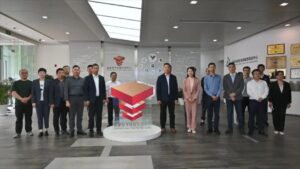
If we consider technology transfer from the perspective of worldwide industrial transformation and upgrading and China's economic development stage, we must enlarge the time and space scales in order to see the big "potential", and only when we follow the trend can we achieve our career. If we consider technology transfer as a career or as a way for enterprises to strategically layout their business, now is a very good time to start.
General remarks - the so-called general trend
On the one hand, China's outward-looking economic performance is escalating.
From the lower-order use of comparative advantage for substitution (exchanging China's natural resources, manpower and technology for overseas markets and overseas scarce natural resources and raw materials) to the current allocation and sharing of global resources through capital. The shift from substitution to sharing is actually a shift from relying on resource endowments to pursuing total factor productivity (TFP) enhancement, i.e. sharing global markets, human resources, technology, and scarce natural resources by capital-based means. This is a shift in the capacity camp.
On the other hand is the upgrading of China's talent pool.
(1) China's entrepreneurial community has grown, and they have adapted to making profits in the midst of great uncertainty, practiced the skills of rapid iteration and fuzzy and flexible decision-making, and adapted to the dynamic competition of globalization.
2) China's application-oriented, unoriginal, test-based education and the introduction of foreign companies in the first two decades have created the world's largest group of engineers with accumulated capabilities in different fields, as well as a number of clusters of innovation-absorbing enterprises around large enterprises. As a result, China has strong cross-industry and cross-technology system integration capabilities.
The shift in the capability camp, i.e., the shift in roles combined with the improvement in capabilities, has led to a significant adjustment in the behavior patterns of Chinese companies. From a purely trade-based, global production-supporting competitive model to a strategic, innovation-driven model that focuses on proprietary core strengths. Considering also the significant global ranking of China's domestic-demand economy, the core competency that a large number of Chinese companies are committed to improving or reinventing is to deepen their domestic demand, using overseas technologies or brands to graft onto their domestic parent and add to their core competencies.
Laying out technology transfer and following the "trend".
It is in this context that technology transfer and its other manifestation ¬- international mergers and acquisitions- have become a major trend. In line with this trend, previously serious problems will be solved in the course of development, such as the protection of intellectual property rights, the optimization of the business environment, the transformation of the role and control of government, the adjustment of the development model of education and human resources training, and the increased importance that society attaches to innovation and its tolerance for risk.
Technology transfer in terms of "volume"
Under this trend, we are vigorously deploying technology transfer as an engine to drive national innovation. In the strategic layout of technology transfer, we focus on two core areas.
I. Key to improving technology transfer and technology transformation.
Second, how capital is organically integrated into each stage of the process.
The first step is to create an environment for technology transfer, and the following approach is mentioned along with the implicit premise.
(1) We build our resource networks to gather more supply and demand for technology, on the premise that there is always more that can be matched and transferred.
(2) We gather the various service providers in the whole process of technology transfer in order to find more matches and to solve the obstacles affecting the transfer of technologies other than technology, based on the premise that the technology is essentially transferable, but the supporting services are not enough.
3) The logic of the premise that we use capital and capital-like instruments such as securitization or exchanges for accommodation is still essentially that the technology is transferable, it just needs catalysts, lubricants and a centralized trading venue.
None of this is really making large amounts or improving quality yet, just making what could have happened happen and showing up.
Technology transfer in terms of "quality"
Let's go back to the origin of the problem, the two key words of technology transfer, "technology" and "transfer", the core issue is to give "technology" to "transfer". "Getting out requires that the technology reach a transferable state and that the supply and demand sides of the transfer have a clear purpose.
From a global perspective, no matter how good the advanced countries are at institutional and market environment, technology transfer is still not smooth, not because of lack of resource base, not because of lack of professional services (patent analysis, legal, transaction structure design, etc.), not because of lack of mature and perfect capital market, but the most essential reason.
There is a gap between the supplied technology and the commercially and industrially available technology needed by the demand side (even if the technology is already industrialized and transferred, there is still a readjustment process according to the clear use of the demand side).
Because technology sources such as university research institutes are about doing 0-1 or 1-10, which is an attribute of scientific research itself (whether it is the research system or the individual capabilities of the researchers).
The market-based business is to do 1w-1b, which is an inherent property of market competition (cost, time, cash flow, uncertainty, the individual capabilities of engineers, etc.).
There is a rationality in existence: the market spontaneously makes up for the gap in order to realize the innovation drive, so there is the phenomenon of horizontal projects in research institutes, independent professional CROs in the market, university spin-off companies, etc. All of these approaches do things from different paths to compensate for the gap. All of these approaches have done things to compensate for the gap in different ways.
We are trying another route, or rather a recombination of existing routes. We have built an experimental platform in collaboration with the industry, which allows us to externalize the transversal projects of research institutes and make the mechanism more flexible; at the same time, we have the capability of CRO; we can generate derivative companies more directly, we can design the structure of derivative companies better, and we can get better access to capital.
At the same time, our experimental platforms can be organized and operated from an industrial perspective, and can be designed and operated by industrial engineers and capital market experts. We try to use a number of experimental platforms as a vehicle on which we can build a small habitat specifically to complement the gap.

We see the establishment of experimental platforms not only as an indispensable part of the larger system of technology transfer, but also as the key to solving the problem of technology transfer from its origin.
In the process of technology transfer and transformation, we guide capital to be integrated in all aspects. We set up pools of funds closely related to technology transfer and transformation, and design benefit bundling and redistribution mechanisms based on the risk appetite of funds of different attributes. Such pools need to include the following.





